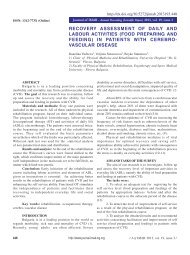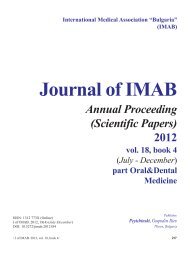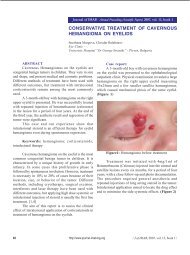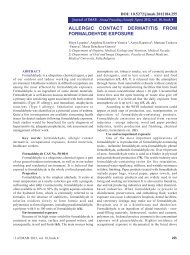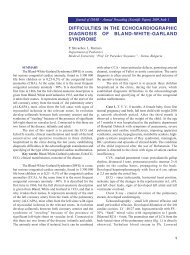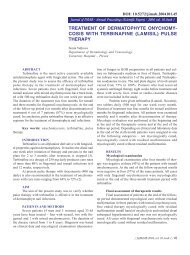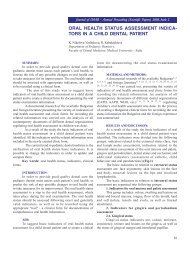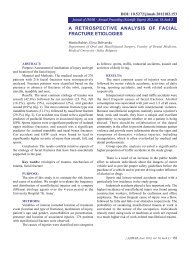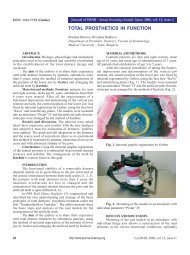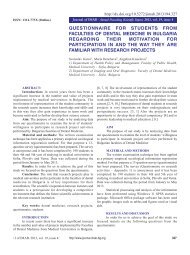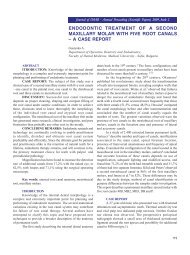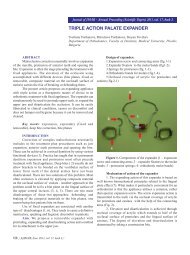BILE DUCT SYSTEM MALFORMATION ... - Journal of IMAB
BILE DUCT SYSTEM MALFORMATION ... - Journal of IMAB
BILE DUCT SYSTEM MALFORMATION ... - Journal of IMAB
You also want an ePaper? Increase the reach of your titles
YUMPU automatically turns print PDFs into web optimized ePapers that Google loves.
developmental, extensive resorption <strong>of</strong> the primitive bile<br />
ducts leads to the final stage, in which a network <strong>of</strong> fine<br />
bile ducts surrounds the portal vein .Insufficient resorption<br />
<strong>of</strong> ductal plate can lead to large dilated segments <strong>of</strong> the<br />
primitive bile duct surrounding the central portal vein (bile<br />
ducts that originally encircle the portal vein fail to involve<br />
properly, giving rise to a cystic dilation). This malformation<br />
may occur at the level <strong>of</strong> the large segmental ducts (giving<br />
rise to Caroli’s disease with enlarged segmental ducts,<br />
sometimes localized) <strong>of</strong> intermediate size bile ducts (giving<br />
rise to Caroli’s syndrome with combines enlarged segmental<br />
bile ducts that are more diffuse and congenital hepatic<br />
fibrosis) These events can also occur at the level <strong>of</strong> the<br />
interlobular bile ducts (giving rise to Von Meyerburg<br />
complexes or to polycystic liver disease (3).<br />
The malformation responsible for (most) choledocal<br />
cyst is an anomalous junction <strong>of</strong> the biliary and pancreatic<br />
ducts. In the normal situation, both ducts join into a<br />
common channel, the length <strong>of</strong> which is shorter than the<br />
length <strong>of</strong> Oddi’s sphincter. Hence, reflux from pancreatic<br />
fluid into common bile duct (or <strong>of</strong> bile duct into the<br />
pancreatic duct) is prevented. Should an anomalous<br />
proliferation <strong>of</strong> the biliary epithelium occur during fetal life,<br />
this common duct will become longer than the length <strong>of</strong> the<br />
sphincter (which remains constant) and reflux will occur. The<br />
reflux <strong>of</strong> pancreatic fluid into common bile duct is thought<br />
to be responsible for bile duct dilation and inflammation <strong>of</strong><br />
the epithelium.<br />
This common channel which can be identified by<br />
cholangio-pancreato MRI, endoscopic ultrasound or<br />
retrograde cholangiography, is present in 95% or more <strong>of</strong><br />
choledocal cysts.<br />
However, a common channel will not necessarily<br />
produce a choledocal cyst;beside , functional pancreatobiliary<br />
reflux may occur despite a normal common channel(<br />
this entity is called occult pancreatic-biliary reflux) (4).<br />
The common consequences <strong>of</strong> Coroli’s disease /<br />
syndrome and choledocal cysts are bile stasis, pigmental<br />
stone formation (as well as protein plugs in the case <strong>of</strong><br />
choledocal cyst) and malignant transformation. As a rule,<br />
the disease may remain silent for decades or give rise to<br />
biliary pain (simple obstruction) or pancreatitis (should a<br />
stone or a protein plug migrate). However, symptoms<br />
become much more severe once bile becomes infected,<br />
either spontaneously, or as a result <strong>of</strong> endoscopic<br />
manoeuvres. Cholangitis at that stage becomes the leading<br />
symptom and endoscopic (or percutaneous) invasive<br />
approaches should be avoided in asymptomatic or<br />
symptomatic patients.<br />
MALIGNIZATION<br />
The risk <strong>of</strong> malignant transformation (a likely<br />
dysplasia, adenoma, adenocarcinoma sequence) is related<br />
to stasis and chronic inflammation. This risk is correlated<br />
with age (is exceptional in children) and septic contamination<br />
<strong>of</strong> bile (5, 6). For choledocal cysts, the incidence is<br />
estimated to be 8% before age <strong>of</strong> 40 and 25% thereafter and<br />
is clearly increased when a prior cysto-digestive<br />
anastomosis has been performed (this treatment is<br />
nowadays contraindicated) (7). For Caroli disease/<br />
syndrome, the reported incidence ranges between 10 and<br />
25 %( 8).Of not, pancreatic fluid reflux ( for choledocal cysts)<br />
may in itself result in malignant transformation, nor only in<br />
the choledocal cyst bur also anywhere else in the bile duct<br />
and in particular the gallbladder where stasis naturally<br />
occurs. Hence, gallbladder malignancy may occur not only<br />
in patients with a choledocal cysts with anomalous<br />
pancreatico-biliary junction, but also in patients with an<br />
anomalous pancreatico-biliary junction without a choledocal<br />
cyst( and recognizing this condition is an indicatin for<br />
prophylactic cholecystectomy).<br />
TREATMENT<br />
The risk <strong>of</strong> malignant transformation is an indication<br />
for treatment <strong>of</strong> choledocal cyst that should include<br />
resection <strong>of</strong> all the cystic dilation, cholecystectomy and<br />
Roux-en-Y bilio-digestive anastomosis. This apparently<br />
straightforward procedure in fact turns out to be associated<br />
with high morbidity rate, inparticulare from the intra- and<br />
retropancreatic dissection <strong>of</strong> the cystic dilatation(5).<br />
Treatment <strong>of</strong> Caroli’s disease (without congenital<br />
hepatic fibrosis) may occasionally rely on partial liver<br />
resection if the involvement is localased.Caroli’s syndrome<br />
(diffuse involvement with congenital hepatic fibrosis) can<br />
only be cured by liver transplantation.<br />
The most common indication for transplantation in<br />
these series was recurrent cholangitis. Most patients had<br />
associated polycystic kidney disease or hepatic fibrosis. As<br />
the risk <strong>of</strong> this treatment is not very different from the risk<br />
<strong>of</strong> malignant transformation, there is no consensus that<br />
prophylactic transplantation should be indicated in<br />
symptomatic patients.<br />
CONCLUSION:<br />
Cystic diseases <strong>of</strong> the system are congenital<br />
disorders, related to the embryological developmental and<br />
basis structure called hilar plate. Clinical presentation<br />
includes dilatation <strong>of</strong> intra and extra hepatic bile ducts,<br />
cholangitis, bile duct stone formation, dilatation and<br />
jaundice. The malignant transformation is the most<br />
dangerous complications. Used imaging techniques such as<br />
ultrasound, CT, MRI cholangiography diagnosis can be<br />
verified. If monolobar liver dilatation is diagnosed, liver<br />
resection is method <strong>of</strong> choice. For complicated and bilobar<br />
liver involvement liver transplantation is indicated.<br />
Extra hepatic dilatation presented by choledocal cysts<br />
necessitates resection and biliodigestive anastomosis.<br />
67



